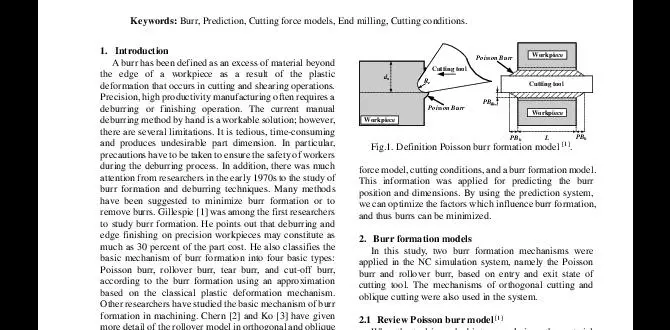Unlock Precision Machining with the Right Carbide End Mill: A Beginner’s Guide
Are you looking for the perfect tool for your metal machining projects? Understanding carbide end mills, especially specific types like the 1/8 inch with a 6mm reduced neck for titanium, is key to achieving tight tolerances and excellent results. This guide breaks down everything you need to know to select and use them effectively.
Welcome to Lathe Hub! I’m Daniel Bates, and I’ve spent a lifetime in the workshop, turning metal and wood into amazing things. I know that getting started with machining can feel a bit overwhelming, with all the different tools and terms. But don’t worry! My goal is to make things clear and simple, especially when it comes to tools like carbide end mills. They might sound technical, but they’re incredibly useful once you understand them. Today, we’re diving into the world of carbide end mills. We’ll cover what they are, why they’re important, and help you understand how to choose the right one for your projects, even those needing super-fine accuracy. Let’s get your projects moving with confidence!
Understanding Carbide End Mills
Carbide end mills are essential cutting tools used in milling machines to create shapes, slots, pockets, and contours in various materials. They are particularly powerful because they are made from tungsten carbide, a very hard and durable material. This hardness allows them to cut tougher materials like steel, stainless steel, and even exotic alloys at higher speeds and with greater precision than high-speed steel (HSS) end mills.
What is a Carbide End Mill?
At its core, a carbide end mill is a rotary cutting tool. Think of it like a drill bit, but designed to cut sideways as well as downwards. It has multiple cutting edges (flutes) that remove material as it spins and moves through the workpiece. The “carbide” part refers to the material – sintered tungsten carbide – which is incredibly hard. This makes carbide end mills ideal for demanding machining tasks.
Why Choose Carbide?
The primary advantage of carbide is its hardness and resistance to heat. This means:
- Increased Cutting Speed: You can often machine materials faster with end mills made of carbide compared to HSS.
- Longer Tool Life: They resist wear much better, meaning they stay sharp for more cuts.
- Ability to Machine Hard Materials: Carbide excels at cutting tough materials like hardened steels, titanium alloys, and composites that would quickly dull or break an HSS tool.
- Better Surface Finish: For many applications, carbide can produce a smoother surface finish on the workpiece.
However, carbide is also more brittle than HSS. This means they can chip or break if subjected to excessive force or improper use, like plunging too fast at an angle or crashing the tool into the workpiece. Careful handling and machine rigidity are important when using carbide tools.
Key Features of Carbide End Mills
When looking at different end mills, you’ll see various features that affect their performance:
- Material: While we’re focusing on carbide, it’s good to know HSS is an alternative, usually for softer materials or less demanding tasks. Carbide offers superior performance for harder materials and higher production rates.
-
Number of Flutes:
- 2 Flutes: Good for plunging, clearing chips in softer materials, and general-purpose work.
- 3-4 Flutes: Excellent for general machining in steels, cast iron, and harder materials. Offers a good balance of cutting performance and chip evacuation.
- 4+ Flutes: These are often called “finishing end mills.” They provide a smoother surface finish because there’s less space between the flutes for chip evacuation, suggesting they are best used for lighter finishing passes, not heavy material removal.
-
Coating: Many carbide end mills come with coatings to improve performance. Common coatings include:
- TiN (Titanium Nitride): Gold color, adds hardness and lubricity, good for general-purpose machining of steels and cast iron.
- TiCN (Titanium Carbonitride): Gray/purple color, harder than TiN, good for abrasive materials and higher speeds.
- AlTiN (Aluminum Titanium Nitride): Black/purple color, excellent heat resistance, ideal for machining stainless steels, exotic alloys, and high-temperature materials.
- ZrN (Zirconium Nitride): Offers good performance on aluminum and plastics.
-
Helix Angle: This is the angle of the flutes.
- Low Helix (0-30 degrees): Offers more rigidity and strength, good for harder materials and heavy cuts.
- Standard Helix (30-45 degrees): Good all-around performance for a wide range of materials.
- High Helix (45+ degrees): Provides smoother cutting action, better chip evacuation (especially in softer materials), and can reduce chatter.
-
End Geometry: The shape of the tip.
- Square End: The most common type, creates sharp 90-degree corners.
- Ball End: Produces a rounded profile, ideal for creating fillets or 3D contours.
- Corner Radius: A square end with a small radius applied to the corners, adding strength and preventing chipping.
Understanding Your Specific Keyword: “carbide end mill 1/8 inch 6mm shank reduced neck for titanium grade 5 tight tolerance”
This is a very specific request, and let’s break down what each part of that keyword tells us about the tool:
Carbide End Mill: The Core Tool
As we’ve discussed, this tells us it’s made of tungsten carbide, built for durability and cutting tough materials.
1/8 Inch Cutting Diameter
This is the diameter of the cutting part of the end mill. A 1/8 inch (approximately 3.175mm) diameter is quite small. This makes it suitable for:
- Machining fine details.
- Creating small slots or pockets.
- Working on smaller parts or in confined spaces.
- Applications requiring high precision where large tools wouldn’t fit or be precise enough.
Working with small diameter tools requires a rigid machine setup and careful control of feed rates and speeds to avoid tool breakage. They are less efficient for removing large amounts of material quickly.
6mm Shank
The shank is the part of the end mill that is held in the tool holder (like a collet or chuck) in your milling machine. A 6mm shank is a standard metric size. This means it will fit into a 6mm collet or a tool holder designed to accept 6mm shanks. Common shank sizes include 1/8″, 1/4″, 3/8″, 1/2″ (imperial) and 3mm, 4mm, 6mm, 8mm, 10mm, 12mm (metric).
Reduced Neck
This is a crucial feature for this particular end mill. A “reduced neck” means that behind the cutting flutes, the diameter of the end mill shaft is smaller than the cutting diameter. For example, an end mill might have a 1/8 inch cutting diameter but a 3/16 inch or 1/4 inch neck. However, in this specific case with a 6mm shank, the feature is likely: the cutting diameter is 1/8 inch (approx 3.175mm), but the neck diameter might be slightly larger than 1/8 inch but still smaller than a standard 6mm shank for its full length, or it could mean that the end mill has a 1/8″ cutting diameter and a standard 6mm shank, but the part of the shank immediately behind the cutting head tapers down to provide clearance. The most useful interpretation for a “reduced neck end mill” is often a tool where the body (the part engaging with the material) is reduced in diameter behind the cutting edges to allow for deeper cuts or to reach into confined spaces without the non-cutting surfaces of the shank rubbing against the workpiece. This is sometimes called a “neck relief” or “stub neck” feature, though the term “reduced neck” can be used more broadly. For a 1/8″ cutter, a reduced neck often implies the shank is still a 6mm diameter, but the clearance behind the cutting head is enhanced. If the diameter of the neck is significantly smaller than the shank diameter (e.g., an 1/8″ cutter with a 1/4″ shank that has a neck ground down to 3/16″ behind the flutes), this provides clearance. Given the 6mm shank, it’s most likely that the effective cutting portion is 1/8″ and the shank is 6mm, with a clearance relief feature on the shank just behind the head. This feature prevents the body of the end mill from rubbing the sides of a deep slot or pocket.
Why is this important? Increased clearance allows the tool to cut deeper into a slot or pocket without the non-cutting parts of the shank rubbing against the sides of the cut. This is vital for achieving precise depth and preventing tool loading or damage.
For Titanium Grade 5
This specifies the intended material. Titanium Grade 5 (often referred to as Ti-6Al-4V) is a very common, high-strength titanium alloy. It’s known for being difficult to machine due to its:
- Low thermal conductivity: Heat generated during cutting doesn’t dissipate well, leading to the cutting edge getting very hot.
- High strength and toughness: It requires significant cutting forces.
- Tendency to work-harden: The material gets harder the more it’s deformed.
End mills designed for titanium typically have specific flute geometries, often a higher helix angle (around 45-60 degrees) to improve chip thinning and evacuation, and are usually coated with high-temperature resistant coatings like AlTiN or TiAlN. They are often made with a specialized carbide grade for impact resistance and wear resistance.
Tight Tolerance
This means the tool is designed and manufactured to incredibly precise specifications. “Tight tolerance” implies that the dimensions, concentricity (how perfectly round the cutter is when spinning), and overall geometry of the end mill are held to very small manufacturing limits. This is essential for applications where the final dimensions of the machined part must be exact. Using a high-quality, tight-tolerance end mill is crucial for repeatable accuracy.
Putting It All Together
A “carbide end mill 1/8 inch 6mm shank reduced neck for titanium grade 5 tight tolerance” is a specialized cutting tool designed for:
- Precision Machining: The tight tolerance and small cutting diameter enable detailed work.
- Difficult Materials: Specifically engineered for the challenges of machining alloys like Titanium Grade 5.
- Deep/Confined Cuts: The reduced neck provides necessary clearance for cutting slots or pockets with precise walls.
- High Performance: Made of carbide for durability and speed, likely with a suitable coating.
This isn’t an everyday “general purpose” end mill. It’s for specific, demanding applications where accuracy and material capability are paramount.
How to Choose the Right Carbide End Mill
Selecting the correct end mill is crucial for successful machining. Here’s a breakdown of factors to consider, going beyond the specific keyword:
Consider Your Material
This is the most important factor. Different materials require different end mill geometries, flute counts, and coatings.
- Aluminum & Copper Alloys: Often benefit from bright finish (no coating) or ZrN coatings. High helix angles (45-60 degrees) with 2-3 flutes are common for excellent chip evacuation and to prevent material buildup.
- Steels (Mild, Carbon, Alloy): A good all-rounder is a 4-flute end mill with a standard helix (30-45 degrees). TiN or TiCN coatings are beneficial. Higher helix angles can be used for smoother finishing.
- Stainless Steels & High-Temp Alloys (like Titanium Grade 5): These are tough and generate a lot of heat. AlTiN or TiAlN coatings are highly recommended to withstand high temperatures and extend tool life. A high helix angle (45-60 degrees) with 2-4 flutes helps manage heat and chip evacuation. Lubrication or coolant is often essential.
- Cast Iron: Typically machined dry or with minimal coolant. 4-flute end mills with a standard helix and often no coating (or a basic TiN) work well. Good chip evacuation is key.
- Plastics: Generally require polished flutes and often a lower helix angle (e.g., 30 degrees) with fewer flutes (2) to prevent melting and ensure a clean cut.
Determine the Operation
What do you want to do with the end mill?
- Slotting/Pocketing: You need an end mill that can plunge (cut downwards) and cut on its periphery. For deep pockets or slots, a reduced neck (like in your specific keyword) or a high-performance end mill designed for plunging is crucial.
- Contouring/Profiling: This involves cutting along the edge of a part. Most end mills can do this. The choice depends on the material and desired finish.
- Face Milling: This is usually done with specialized face mills, not standard end mills.
- Drilling/Plunging: If plunging is a primary operation, consider 2-flute end mills or tools specifically designed for plunging. Many 4-flute end mills are not ideal for deep plunging.
Consider the End Mill Features
Diameter: Choose a diameter appropriate for the feature you need to create. Remember that the largest diameter end mill you can use is often the most rigid and efficient for material removal.
Flute Count: As discussed, more flutes generally mean better surface finish but poorer chip evacuation. Fewer flutes are better for slotting and softer materials.
Helix Angle: High helix for smoother cuts and better chip evacuation in tough materials. Standard helix for versatility. Low helix for maximum rigidity in heavy roughing.
Coating: Essential for high-temperature materials or extended tool life. Choose based on material and cutting speed.
End Geometry: Square end for sharp corners. Ball end for fillets and 3D surfaces. Corner radius for strength and to avoid chipping the workpiece corners.
Shank Type: Standard straight shank, Weldon shank (for set screw locking in tool holders), or reduced neck for clearance.
Machine Rigidity and Power
A small, high-performance end mill like the one in your keyword is best suited for rigid machines. A flimsy machine will lead to chatter, poor surface finish, and broken tools, even with the best end mill. Ensure your spindle has enough power for the material you are cutting.
Using Your 1/8-Inch Reduced Neck End Mill for Titanium
Machining Titanium Grade 5 with a small end mill requires a careful approach. Here’s how to set yourself up for success:
Machine and Setup
Rigidity is King: Ensure your milling machine is as rigid as possible. This means no excessive play in the ways, a tight spindle bearing, and a high-quality tool holder. A small end mill can break very easily if it experiences any shock or chatter.
Tool Holder: Use a high-quality, precision collet chuck or ER collet system. Ensure the collet is the correct size (6mm in this case) and is clean. A worn or runout-afflicted tool holder will destroy your end mill.
Workholding: The workpiece must be held securely. Any movement will lead to tool breakage or poor results. Use clamps, vises, or fixtures that provide maximum support and prevent vibration.
Cutting Parameters: Speeds and Feeds
Titanium demands specific parameters.



